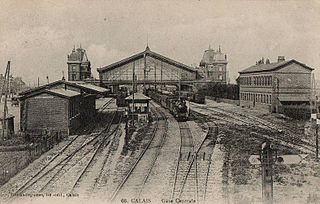
Nord-Pas-de-Calais ; Picard: Nord-Pas-Calés); is a former administrative region of France. Since 1 January 2016, it has been part of the new region Hauts-de-France. It consisted of the departments of Nord and Pas-de-Calais. Nord-Pas-de-Calais borders the English Channel (west), the North Sea (northwest), Belgium and Picardy (south). Until the 17th century, the history of the North was largely in common with the history of Belgium, that of a land that “for almost a thousand years served as a battlefield for all of Europe.” The majority of the region was once part of the historical Southern Netherlands, but gradually became part of France between 1477 and 1678, particularly during the reign of king Louis XIV. The historical French provinces that preceded Nord-Pas-de-Calais are Artois, French Flanders, French Hainaut and (partially) Picardy. These provincial designations are still frequently used by the inhabitants. The former administrative region was created in 1956 under the name "Nord" and maintained that name until 1972 when "Pas-de-Calais" was added. This remained unchanged until its dissolution in 2016.

Armentières is a commune in the Nord department in the Hauts-de-France region in northern France. It is part of the Métropole Européenne de Lille.

The Ligne à Grande Vitesse Nord, typically shortened to LGV Nord, is a French 333-kilometre (207 mi)-long high-speed rail line, opened in 1993, that connects Paris to the Belgian border and the Channel Tunnel via Lille.

Hazebrouck is a commune in the Nord department, Hauts-de-France. It was a small market town in Flanders until it became an important railway junction in the 1860s. West Flemish was the usual language until 1880, when French was taught at school by mandate of the French government in an effort to "Frenchify" the people of the Nord-Pas-de-Calais and to extinguish their Flemish roots. The development of the railways linked Hazebrouck to Lille to Calais and Dunkirk.

Calais-Fréthun station is an SNCF international railway station in the suburbs of Calais, France. It is one of four stations serving the town; the others are Calais-Ville in the town centre, Fontinettes in the suburbs, and Beau Marais in the suburbs.

TER Nord-Pas-de-Calais was the regional rail network serving Nord-Pas-de-Calais région, France. In 2017 it was merged into the new TER Hauts-de-France.

Calais-Ville station is a railway station in the city centre of Calais, France.

Lille-Flandres station is the main railway station of Lille, capital of French Flanders. It is a terminus for SNCF Intercity and regional trains. It opened in 1842 as the Gare de Lille, but was renamed in 1993 when Lille Europe station opened. There is a 500m walking distance between the two stations, which are also adjacent stops on one of the lines of the Lille Metro.

Lille-Europe station is a SNCF railway station in Lille, France, on the LGV Nord high-speed railway. The station is primarily used for international Eurostar and long-distance SNCF TGV services, although some high-speed regional trains also call at the station. The station was built in 1993 to be used as a through station for trains between the UK, Belgium, and the Netherlands, as well as French TGV services, except those coming from Paris which normally terminate at Lille-Flandres station. There is a 400-metre (1,300 ft) walking distance between the two stations, which are also connected by the Lille Metro and Lille tramway.
TER-GV, a portmanteau of TER and TGV, are regional TGV linking relatively nearby cities using the LGV Nord dedicated high-speed line (Paris-Lille-Calais). So far, those trains only operate in the Hauts-de-France region.

Longueau station is a railway station in Longueau near Amiens, France. It is situated on the Paris–Lille railway. Longueau is served by trains of the TER Hauts-de-France and Intercités networks. As well as serving as a passenger station, Longueau is also home to one of the North of France's largest engine sheds, which include a roundhouse and turntable.

Dunkirk station is a railway station serving the town Dunkirk, Nord department, northern France. This part of French Flanders is near West Flanders in Belgium.

Arras station is a railway station serving the town Arras, Pas-de-Calais department, northern France. This station, which opened in 1846, is located on the Paris–Lille railway and Arras-Dunkirk railway and accessible from LGV Nord. The train services are operated by SNCF.

Les Fontinettes station is a railway station in Calais, France. It is on a triangular junction, where the Coudekerque-Branche–Fontinettes railway, Lille–Fontinettes railway and Boulogne–Calais railway all meet. Some trains pass through the station twice, before and after calling at Calais-Ville.

The Boulogne–Calais railway is an electrified double track railway running between the ports of Boulogne-sur-Mer and Calais in France. An extension of the Longueau–Boulogne railway it meets the Lille–Fontinettes railway and Coudekerque-Branche–Fontinettes railway to Dunkirk at Les Fontinettes station in Calais.

The Arras–Dunkirk railway is a French railway which runs from Arras to Dunkirk. Electrified double track it is 113 kilometres long.

Lens is a railway station in Lens, Pas-de-Calais, France. The building was built in 1926–1927 to resemble a steam locomotive with a 23-metre-high (75 ft) tower as the chimney. The architect was Urbain Cassan. In December 1984 it was listed as a French National Heritage Site.

Béthune station is a railway station serving the town Béthune, Pas-de-Calais department, northern France. It is situated on the Arras–Dunkirk railway and the Fives–Abbeville railway. The station is served by high speed trains to Paris and Dunkerque, and by regional trains towards Lille, Arras, Saint-Pol-sur-Ternoise and Calais.

Biache-Saint-Vaast station is a railway station serving the commune of Biache-Saint-Vaast, Pas-de-Calais department of France. It is located at kilometric point (KP) 204.333 on the Paris-Lille railway.

Saint-Pol-sur-Ternoise station is a railway station serving the town Saint-Pol-sur-Ternoise, Pas-de-Calais department, northern France. It is situated on the Saint-Pol-sur-Ternoise–Étaples railway, the Arras–Saint-Pol-sur-Ternoise railway and the Fives–Abbeville railway. The station is served by regional trains towards Lille, Arras, Béthune and Étaples.























